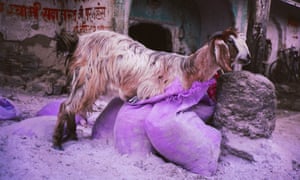 |
| Upstairs Gallery -'Animality' at Marian Goodman Galley |
 |
| Gabriel Orozco 'Goat in Purple Bag' 1996 |
"Animality quietly crept up on me and completely took me
by surprise. It was without doubt one of the most exciting exhibitions I saw during 2016, on
for just over four weeks in November-December at the London Marian Goodman
Gallery in Soho."
Imagine the best of the science and unusual curiosities
of a Wellcome Collection exhibition mixed with works by modern and contemporary artists
and you’ll have a good idea of what made this exhibition so special. ‘Animality’
featured the work of over seventy ‘creatures’ comprising of artists,
philosophers, writers, scientists and illustrators throughout history (Darwin,
Heidegger, Foucault are here and more) seeking to understand the complex
relationship humans have with animals; what it means to be human, what it means
to be an animal and how the division between the two is sometimes not as
distant (if at all) as we thought. What works so well within this exhibition
(and other exhibitions I have seen of this type) is this fusion between
science, history and philosophy either integrated with art works or presented
in context alongside them. This is science and history at its most engaging,
its most visual and, I think, is significantly longer lasting in memory for it.
 |
| Albrecht Durer 'The Rhinoceros' 1515 |
From the graphic illustrations of Charley Harper to the
observed biological illustrations of Earnst Haeckel and woodcut of an armour
plated Rhinoceros by Albrecht Durer (pic), ‘Animality’ covers a breadth of ways
in which humans have not only sought to represent animals in art but in doing
so were also attempting to understand and educate themselves and others in outcomes that are in
some cases playful and in others personal or documentarian. They each offer
insight into either our fear or love of beasts, bugs and creatures of all shapes
and sizes; those that can eat us, others be eaten. There is a whole Zoo here,
tigers, elephants, cats, slugs, horses, magpies, goats and camels including mythical
creatures and hybrids throughout history. Despite being a mixed 'museum meets art' exhibition there is no hierarchy of one
depiction of ‘animality’ being more significant than any other which is what
makes it particularly rewarding, both the scientific and
historical are presented alongside the whimsical and fun, grouped together into
themes of origins, markings, crossings, variations, trace and extinction.
Roni Horn’s photos featuring the backs of bird’s heads
(pic) are surprisingly confrontational and unfamiliar, unsurprising as it is an angle we are not
accustomed to seeing birds being taken at. Similarly unsettling is Sarah
Jones’s ‘Black Horse’ is striking not only in its scale but in its black
on black image of a horse that almost disappears and reappears so we are forced
to look at the catches of light on the muscles that define the form of the
body. Elsewhere another horse piece by Steve McQueen, ‘Running Thunder’ depicts
a horse that at first appears to be asleep in a grassy meadow, the scene a
relatively still one until we see a fly pitch around its eyes and we make the
startling discovery that this horse is in-fact dead. It is more a comment on
our relationship with how we perceive and ‘expect’ to see animals in art; here
the expectation of the horse as heroic or symbol of wealth as familiar in
paintings by George Stubbs is given a dark twist. A goat stands inside a purple
bag (pic) in one of a series of photos by Gabriel Orozco but is more
photography than it is fitting in ‘nature photography’ as they do not attempt
to present an ideal as much as a reality. Danh Vo reminds us of history in presenting
a photo of a pekingese on a throne, the dog once belonging to Queen Victoria plundered
from Beijing by British troops during the second opium war.
Amidst this Noah’s Ark-like procession of animals Carsten
Holler’s pink octopus (pic) creeps along the gallery floor adding an element of
unexpected fun to the proceedings, making us aware of the space in which we inhabit together; like many of the works in this exhibition on
its own it doesn’t have a huge amount to say but as part of the whole they form a welcome
visual rest bite. Over by the stairs Fischli and Weiss’s projection of a cat
lapping up cream plays on continuous loop which is fun if nothing for its almost
banal familiarity. There is an almost absurd amount of work to process which only
compounds why animals as a subject matter in art is so diverse and why even early
George Shira photography first published in National Geographic in 1906 being
shown alongside contemporary art works does prove that photography and art are still
relevant in aiding education, research and conservation. Seeing Pavia and Gusmao’s
slow-motion film of a peacock strutting should be a relatively familiar sight
to anyone who’s ever been to a zoo or heritage garden but this film acts as a
reminder, as though you were seeing them for the first time, to just how strange, marvellous and remarkable
a bird they really are. Or if anything the works in this exhibition only
highlight that the real mystery and most complex creature of all is in-fact the
artist. Intellectually challenged I proceeded to scramble on two legs out the
gallery door and into the jungle outside....


